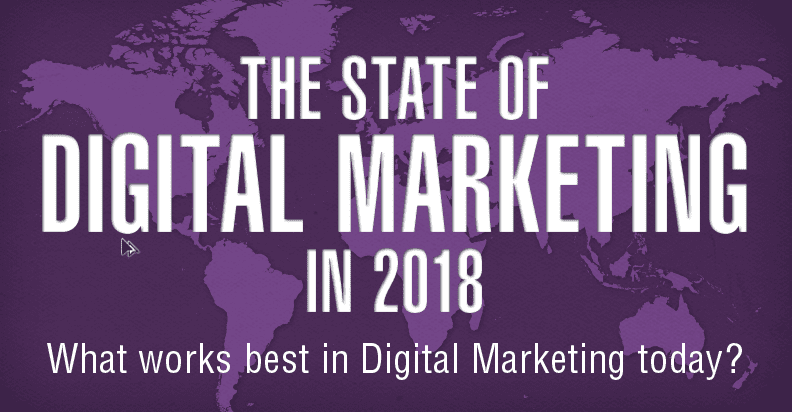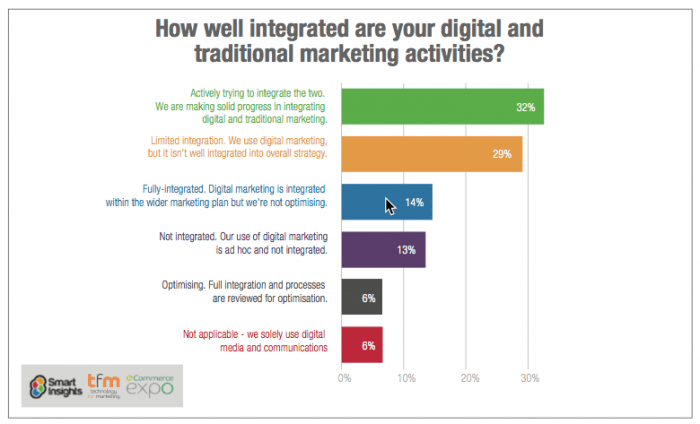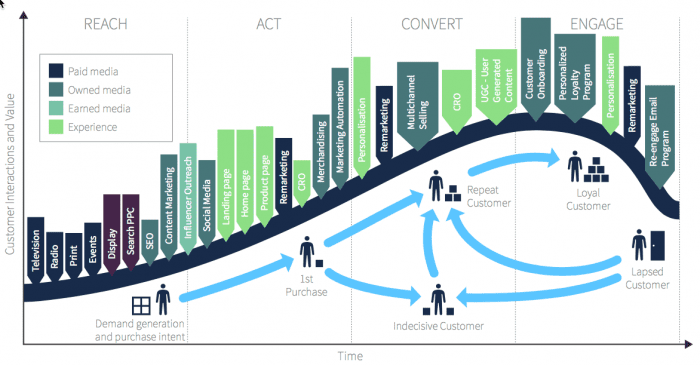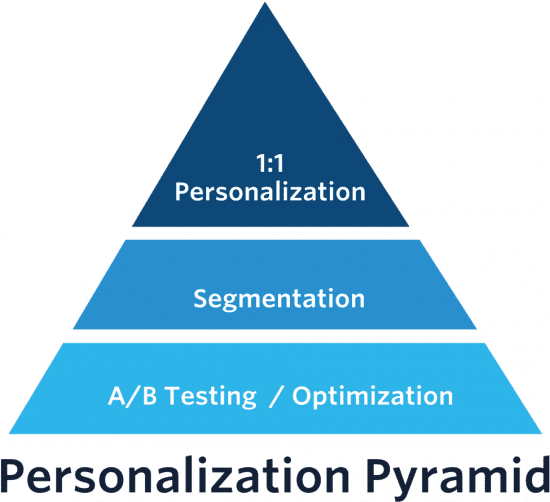How to integrate digital media and technology to increase the contribution of digital marketing
Please see our latest 2019 marketing trends posts for our most recent insights.

I feel fortunate to have followed some of the amazing major changes in digital marketing and technology over the last 15 or 20 years. I'm sure you will have enjoyed living through, following and acting on these changes too. Looking back, we've seen a phenomenal growth in the importance of organic, then paid search, then social media and more recently, incredible worldwide growth in mobile and particularly smartphone usage.

As well as this article, to help Smart Insights members, we also have a more detailed free download of the marketing megatrends, which are 9 digital marketing and martech megatrends that will help give you an edge in 2017.
Download Free resource –Integrated marketing megatrends
Learn about the 10 megatrends that have already helped leading companies future-proof their strategies by ensuring all aspects of marketing are integrated.
Access the
Looking forward, in this article, I'm going to review 10 new trends which I believe, based on my experience consulting and training, are relevant for marketers across businesses of a range of sizes. But, first, I'm interested to know what you think will be important to you and your business in 2018.
Which marketing trend will be most important to you and your business in 2018?
We have asked this question over the past few years and it's been really interesting to see what 'rocks your digital world' since there are some common themes amongst the top 3 and some activities surprisingly low. The question we asked was around the most important commercial trends. We had around 850 votes from marketers in different types of business from around the world. Thank you if you voted! Here's what you thought:

By asking for just one technique from many, this helps shows the top 3, 5 or 10 top-level trends. There are a clear top three techniques, each over 10%, but with a long tail of many other techniques showing the potential for optimising different areas of digital marketing. Let's take a look at the top three...
It's no surprise to see content marketing 'top of the pile' since this has been in the top three for each of the years we have run this poll. We see content marketing as the 'engagement' fuel that powers all digital communications from search to social to email marketing to creating website experiences which convert. Our content marketing toolkit is popular since members want to learn a more planned approach to mapping content against personas across the customer journey.
More of a surprise is that Big Data is in second position. I think this is because marketers are aware of the potential of using data as what we call 'actionable insight'. To help the decision on which technique to choose, we expanded upon the short labels you see in some polls to help scope the response more carefully. 'Big Data' is a nebulous term, but when we expanded the definition to include insight and predictive analytics, it shows the value of the specific marketing techniques for Big Data and this help explains why this is in position number two.
In third position is Artificial Intelligence and Machine Learning. We added this to the poll this year with the interest in it and it's 'straight in at number three'! It's good to see the interest in these techniques which we have been covering a lot on the blog and in our member resources this year. In trend 8 we show how different AI techniques can be mapped against the customer lifecycle.
Here is the full listing of digital marketing techniques:
The ten marketing trends to act on in 2018
If you look at the 14 themes that we covered last year, none of these top-level marketing techniques are especially new, so it's difficult to describe them as new trends or innovations. However, techniques like Big Data and analytics, Content Marketing and Email/Marketing Automation have continued to grow in importance and will be used by many businesses.
So in my look at the trends this year, I'll be looking at integration as the theme. In our research on managing digital marketing (another free member download) you can see that only 6% of companies thought their integration process was completely optimised, yet many are actively working on integration.

Integrated marketing communications or IMC isn't a concept you see written about much on blogs or social media since it's high-level with everyone getting excited at the latest minor innovations from the frightful 5 - at the time of writing we're getting excited about the Animojis in iPhone X for example. Fun, but they're not going to help deliver the most relevant message and offer for an individual, which is the aim of IMC.
So, let's take a look at the 10 trends. You'll notice that in a lot of these predictions, I'll refer to Artificial Intelligence and Machine Learning. It's what I see as the biggest trend to consider in the year ahead. There has been a lot of hype around it in 2017 and we're starting to understand the opportunities. In 2018 it will become more about selecting solutions and implementation.
Trend 1. Integrating Marketing Activities Into the Customer Lifecycle
Given the way the complexity of marketing and digital marketing has increased, techniques like customer journey mapping for different personas are increasing in importance to help define the most relevant communications and experiences for different touchpoints in the customer journey.

To support this, the way I like to think about how to improve the effectiveness of digital marketing is to think from the customers' viewpoint of the communications opportunity available through the customer lifecycle for different types of business.
We define lifecycle marketing as:
Creating a managed communications or contact strategy to prioritise and integrate the full range of marketing communications channels and experiences to support prospects and customers on their path-to-purchase using techniques such as persuasive personalised messaging and re-targeting.
We designed this mind-tool to help members think through all the potential touchpoints across paid, owned and earned media. Then you can perform a 'gap analysis' of the use and effectiveness of lifecycle comms you are using against those you could be using to increase the relevance and response of communications.

Trend 2. Integrating personalization into the user journey / customer experience
To increase relevance and response of comms, website personalization has been widely used within transactional ecommerce sectors like retail, travel and financial services for a long time now.
More recently, lower cost options have become available with different types of solutions. There are many forms of web personalization varying from those integrated into content or commerce management systems; those integrated into analytics solutions or standalone Software as a Service (SaaS) personalization options that integrate with your CMS and analytics. A useful method to review your use of personalization at the top-level is this experience personalization pyramid:

The three levels shown in the chart are:
- 1. Optimization. Structured experiments. AKA AB Testing or Multivariate testing. Google Optimize is an example of one of these services that launched in 2017.
- 2. Segmentation. Target site visitor groups, each one with specialized content to increase relevance and conversion.
Each one still requires separate manual rules and creative to be set up. So returns for this approach eventually diminish after the maximum sustainable number of audience segments has been reached.
- 3. 1-to-1 Personalization. Using Artificial Intelligence (AI) technology to deliver an individualized experience to each customer. 1-to-1 employs some of the same principles as optimization and segmentation, but by offering a solution to their two greatest limitations-delayed results and inability to scale-it represents a fundamentally different approach.
So, the main trend within personalization is increased use of artificial intelligence rather than manual rules. Plus, we can also expect to see Website personalization services being adopted across more sectors than the transactional sectors it has become popular within.
Trend 3. Integrating machine learning into marketing automation
Personalization can also be applied across the lifecycle in email comms. Yet, our research on email marketing shows that despite the widespread use of email and marketing automation systems, many companies don't manage to put in place a full lifecycle contact system like that shown in the lifecycle visual above.
We assessed segmentation and targeting of emails based on the number of criteria that are used from none at all up to dynamic content.

The findings from our State of Email marketing report are shocking: Half (50%) don’t use any targeting whatsoever, less than a third (29%) use basic segmentation for targeting and less than 15% use segmentation and personalization rules to reach specific audiences within their database. This means that they may be missing out on opportunities for automated emails with dynamic content for welcome and nurture of prospects and customers.
Although email marketing automation is another technique where artificial intelligence and machine learning is being applied more often. Using machine learning offers opportunities to automate targeting as it does for web personalization. However, personalization is potentially more difficult since emails, by their nature, have more complex creative. This data suggests to me that many businesses aren't ready for AI and machine learning within email marketing and they need to deploy fundamental triggered automation features first.
Trend 4. Integrating social messaging apps into communications
The increasing use of messaging apps is a trend we have mentioned in previous trends round-ups. According to the latest Ofcom Communications Market research more than half of the total mobile audience used Facebook Messenger (61%) and half used WhatsApp (50%). Both properties are owned by Facebook. The Snapchat mobile app had a reach of 28%, with 10.1 million unique visitors.
We've been looking at some early adopters of marketing applications of these social messaging apps on Smart Insights. Examples include using Pizza Express using Messenger for booking tables and IKEA for customer research.
Trend 5. Integrating video into the customer journey
Video is also increasing in popularity fuelled by social . This breakdown of Google popularity shows the dominance of YouTube. We used to say that YouTube was the second biggest search engine, but this data shows that it is now more popular than Google Search based on number of users in a given month (this research also from the comScore panel via Ofcom).
 This visual reminds us of the opportunities to use video marketing through the customer lifecycle from pre-roll ads in YouTube (just one option, Google has 10 Video ad options), explainer ads on site and retargeting through video.
This visual reminds us of the opportunities to use video marketing through the customer lifecycle from pre-roll ads in YouTube (just one option, Google has 10 Video ad options), explainer ads on site and retargeting through video.
Augmented and Virtual Reality are closely related to video engagement, but although we've been tracking these, we have seen fewer examples and case studies this year. So, do let us know of any examples.
Trend 6. Integrating content marketing into the customer journey using a customer engagement strategy
Video is just one type of content, albeit important. In previous polls about the technique that will give the biggest uplift in future, content marketing has been popular, in the top one or two in the list.
The trend I'm seeing here is that businesses are getting serious about treating content as a strategic resource, that means developing a customer engagement strategy using different media as shown in the lifecycle diagrams above, and at a practical level, developing content for different audiences using techniques like Personas and Content mapping. Our research shows that these customer-centric analysis techniques are growing in importance, which has to be a good thing for consumers and businesses!
Recommended resource: Content Marketing Strategy guide
Trend 7. Integrating search marketing into your content marketing activities
If we look at the top digital sales channels, search marketing is dominant. Social media is far behind in most sectors, despite its ongoing popularity with consumers. We now know that in many sectors social media can be a great tool for engaging audiences with a brand and improving favourability and awareness, but it typically doesn't drive lead volume or sales. So I haven't given social media it's own section, although integrating it with other channels like web, search and email marketing remains relevant. See our recap of SMW London for the latest social media trends.
However, within search marketing there is today relatively little innovation that we get to hear about compared to the past. Looking at natural search shows that the Moz algorithm change history has no entries since the non-specific 'Fred' update in March, whereas in previous years it would have had 5+ with new updates to Panda and Penguin. This is partly down to Google sharing less, with Matt Cutts no longer actively evangelising, although updates are available from John Mueller in their Search team.
Within organic search, one trend I think marketers should be aware of is the changing face of the SERPs as shown by the Mozcast SERPs features update which shows the types of links within a bundle of top 10k keywords they monitor.
It shows the importance of techniques such as Knowledge Panels (important for brands and local businesses); Related questions; featured / rich snippets / quick answers and reviews. We have found that the way these vary across the top 3 to 5 positions can make a big difference in the volume of visits from informational searches.

Within AdWords, referencing Google's list of new features shows more innovation. Much of it is around reporting compared to new ad features for mobile in previous years, but there are some new options like with Enhanced CPC (ECPC) bidding and Smart Display campaigns. This is an example of Google deploying different types of machine learning including Automated bidding Using Target CPA as a basis; Automated targeting which means your ads increasingly show where they’ll get you the most business and automated ad creation from the building blocks you provide, like headlines, descriptions, logos and images.
Trend 8. Integrating marketing technology
If you follow applications of marketing technology you have almost certainly seen Scott Brinker's Martech landscape which has grown to over 5,000 vendors this year.
Our own digital marketing tools wheel seeks to simplify this, but has over 30 categories of insights and automation tools which shows the challenge of integrating marketing technology. The trend here is that there is no let up in tools offering innovative methods to analyse or automate. Our final two categories highlights some of these.
Given the plethora of martech, the most apt definition seems:
'very large amount of something, especially a larger amount than you need, want, or can deal with'
You might expect there would be a trend to increasing use of marketing clouds, but our research suggests there isn't widespread adoption of these.
As we have mentioned throughout this article, machine learning and AI is one of the biggest trends here, see this article and infographic for AI marketing applications across the lifecycle.
Trend 9. Integrating different data sources
This challenge was highlighted to use recently in our members' Facebook group where a member asked about tools for integrating insights from different paid media ad serving tools which can give the best results if managed separately, for example, Facebook, Twitter, LinkedIn ads and Google AdWords. Rivery.io is a new option that has launched recently, that should do well. The trend here is new integrated media insights tools other than Google or Adobe, which can help you compare performance of different media.
These services are surprisingly expensive, particularly since they are additional analysis tools. They're not martech that directly increases leads or sales to the business. For example, I was recently recommended this service (Funnel.io ) that costs a minimum of $200 / month, even if it's solely used to integrate data from multiple sources into Google Sheets. It's a lot when to get the value from these tools you have to ringfence time so that the analytics are reviewed and acted on sufficiently.
Trend 10. Integrating digital marketing insights sources
Our digital marketing tools wheel contains many free and paid sources of insight about your digital marketing. Here, I'm talking specifically about services which help you stay up-to-date. We're avid users of these services since they help us keep readers up-to-date via our own blog, twice weekly newsletters and monthly What's Hot feature.
In a recent article on keeping marketing teams up-to-date, Mark Kelly explains that we recommend using Feedly as a way of aggregating primary marketing news sources via RSS. Plus, I recommend taking a look at Zest which is a Google Chrome extension, new in 2017, which I and the team at Smart Insights use and is well worth checking out. Its curated content is specifically designed for and updated by marketers. Like Feedly, you can use it to review the most useful content recommended by 'the crowd', in this case 'your tribe' of marketers.

Summary presentation
To give you a different format to view some of the visuals, take a look at this Slideshare
It all adds up to digital transformation
So, those are the 10 trends summarizing how businesses are looking to manage the opportunity of digital media, technology and data by integrating it into their marketing. This brings us to our final trend, digital transformation. Our Managing Digital marketing research shows how many businesses are active in transformation projects.

You can see that over one-quarter (30%) of businesses already have a transformation programme in place, with many businesses looking to launch their digital transformation programme imminently. A significant proportion of organizations have no intention to implement a programme, perhaps because they feel it is inappropriate for their type of business, for example, startups and smaller businesses or businesses who are online pure plays.
If you're considering launching a transformation programme, see our toolkit for Business members to Managing a Digital Transformation programme.




















